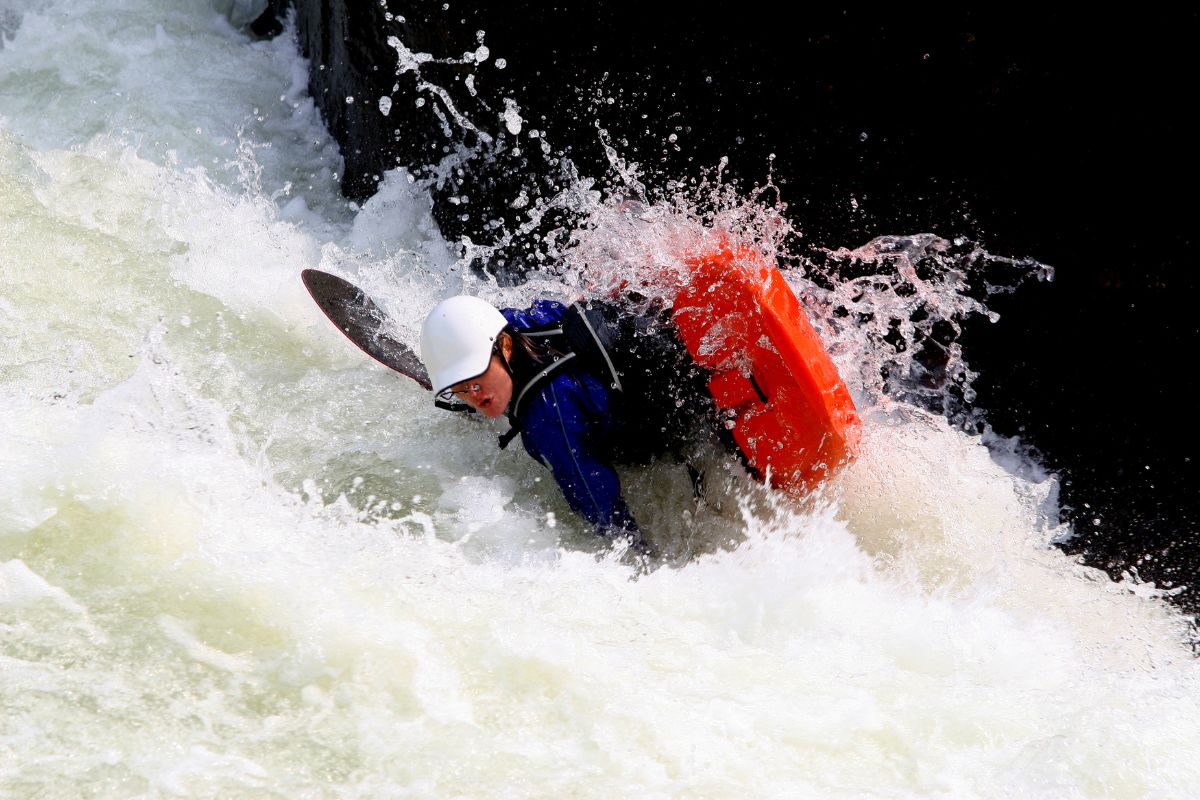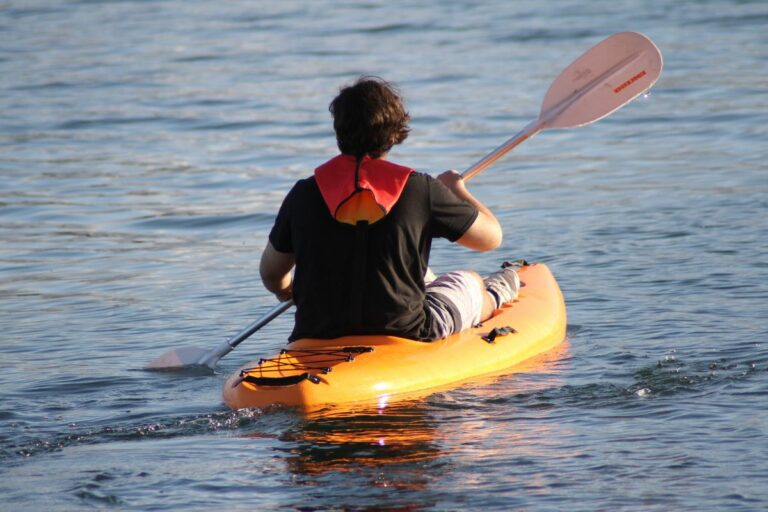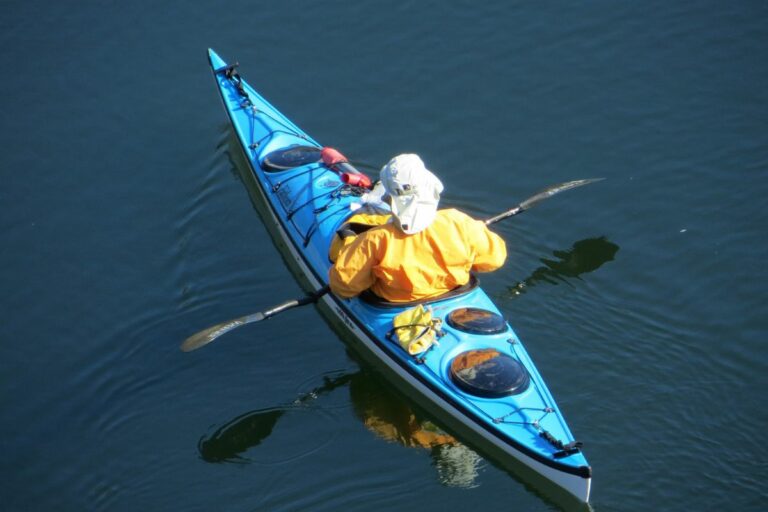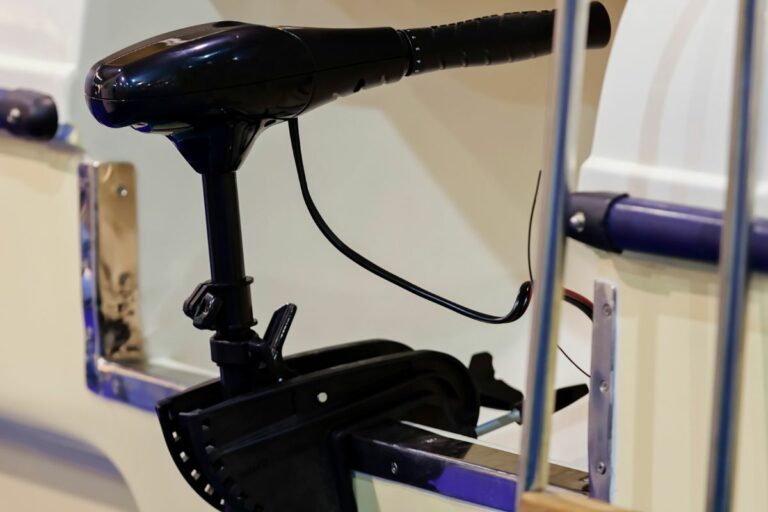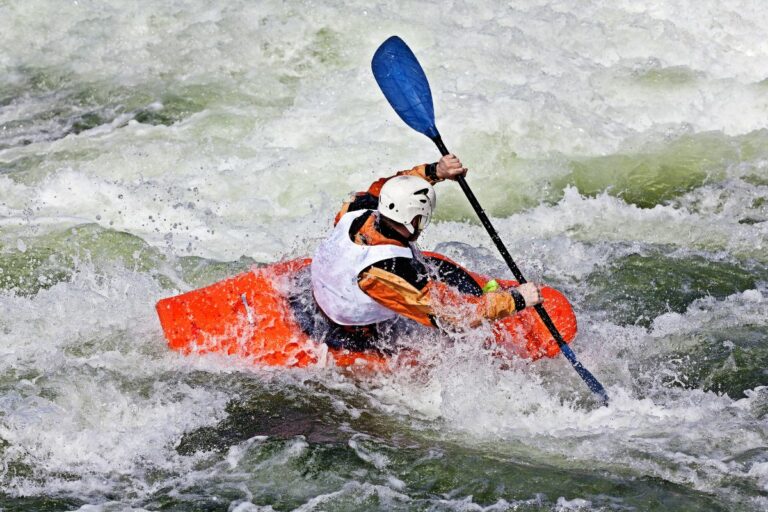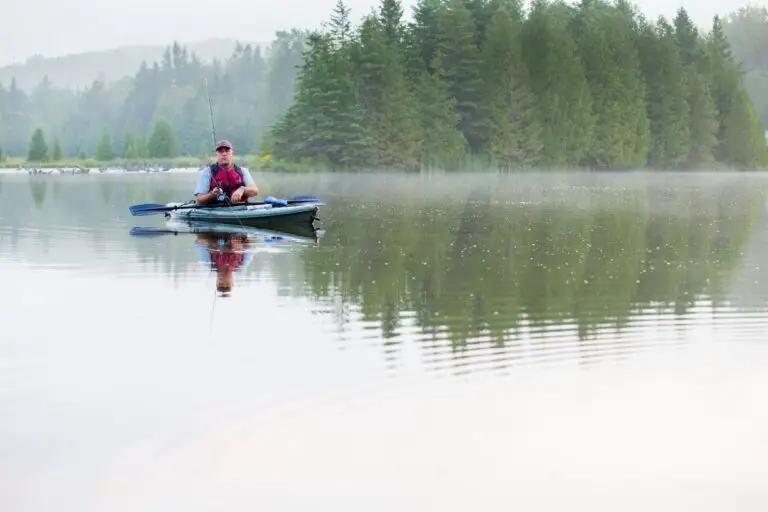Can You Get Stuck in A Kayak If It Flips Over? 5 Steps to Get Free
As with any water sport, there are certain risks involved in kayaking, and one of the most common concerns for kayakers is the possibility of flipping over or capsizing.
While it may seem unlikely, even experienced kayakers can find themselves overturned. But can you get stuck in a kayak if it flips over?
It’s unlikely to get stuck in a kayak when it flips over because most modern kayaks are designed to allow the paddler to escape easily. If your kayak flips, try to stay calm and hold onto the kayak or paddle. Once you’re in a safe position, flip the kayak over, then climb back in or swim to shore.
Keep reading to learn more about whether kayaks can easily flip over, why that happens, and what to do if your kayak flips over to avoid getting stuck.
Table of Contents
Do Kayaks Easily Flip Over?

Kayaks do flip over in certain conditions. However, some kayaks are designed to be more stable than others; therefore, they won’t easily flip over.
Sit-on-top kayaks, which have an open cockpit where the paddler sits on top of the kayak, are generally considered to be more stable and less likely to flip over than sit-inside kayaks because they have a wider and flatter hull design, which provides more stability and buoyancy.
They are also easier to re-enter if flipped, as the paddler can climb back on top of the kayak.
On the other hand, sit-inside kayaks have a more enclosed cockpit where the paddler sits inside the kayak. They have a narrower and more pointed hull design, making them faster, more maneuverable, and less stable.
Additionally, sit-inside kayaks require more skill and balance to paddle effectively and are more likely to flip over if the paddler is inexperienced or encounters rough water.
It’s important to note that no kayak is completely immune to flipping over, and even the most stable kayak can capsize in the right conditions.
Why Do Kayaks Flip Over?
As mentioned before, any kayak can flip over, even if designed to be stable. So, it’s important to understand what causes kayaks to flip over to minimize the chances of that happening.
One common cause of capsizing is rough water conditions, such as large waves or strong currents, which can cause the kayak to lose balance and capsize. Kayaks are also susceptible to flipping if they encounter underwater obstacles like rocks or logs or if they collide with other boats or objects in the water.
In addition to environmental factors, a paddler’s skill level and technique can also contribute to capsizing.
Novice paddlers may not have the experience or knowledge to maintain proper balance and control in the kayak, while experienced paddlers may push their limits and attempt maneuvers beyond their abilities.
Finally, improper weight distribution, such as having too much weight on one side or in the front or back of the kayak, can cause the kayak to become unbalanced and tip over. This can happen when a paddler leans too far to one side, or the gear is not properly stowed in the kayak.
Will A Kayak Sink If It Flips?
When a kayak flips, it will fill up with water, but it will not sink due to its inherent buoyancy. However, the amount of water that enters the kayak will depend on the design of the kayak, as well as the conditions of the water.
If a kayak has an open cockpit, the water will drain out of the kayak once it is turned upright. Meanwhile, if the kayak has a closed cockpit, the paddler will need to manually remove the water by using a bilge pump or by flipping the kayak over and draining it out.
How to Prevent Your Kayak from Flipping?
Here are some tips you can follow to prevent your kayak from flipping:
- Choose the right kayak: Make sure the kayak you are using is appropriate for your skill level and the conditions you will be kayaking in.
- Kayaks with a wider and flatter hull, such as sit-on-top kayaks, are generally more stable and less prone to capsizing than kayaks with a narrower hull, such as sit-inside kayaks.
- Maintain proper balance: Keep your body centered and your weight evenly distributed in the kayak. Avoid making sudden movements or leaning too far to one side.
- Use proper paddling technique: Use a relaxed and efficient paddling technique, and keep your paddle in the water at all times to maintain balance. Avoid paddling too hard or too fast, as this can cause the kayak to become unstable.
- Be aware of environmental conditions: Check weather and water conditions before kayaking, and avoid kayaking in strong currents, high winds, or rough water. Safety first, which means that some conditions are just unsuitable for kayaking, just have an adventure some other time.
- Secure your gear: Make sure all gear is securely stowed in the kayak to prevent it from shifting and throwing off the kayak’s balance.
Can You Get Stuck in A Kayak If It Flips Over?
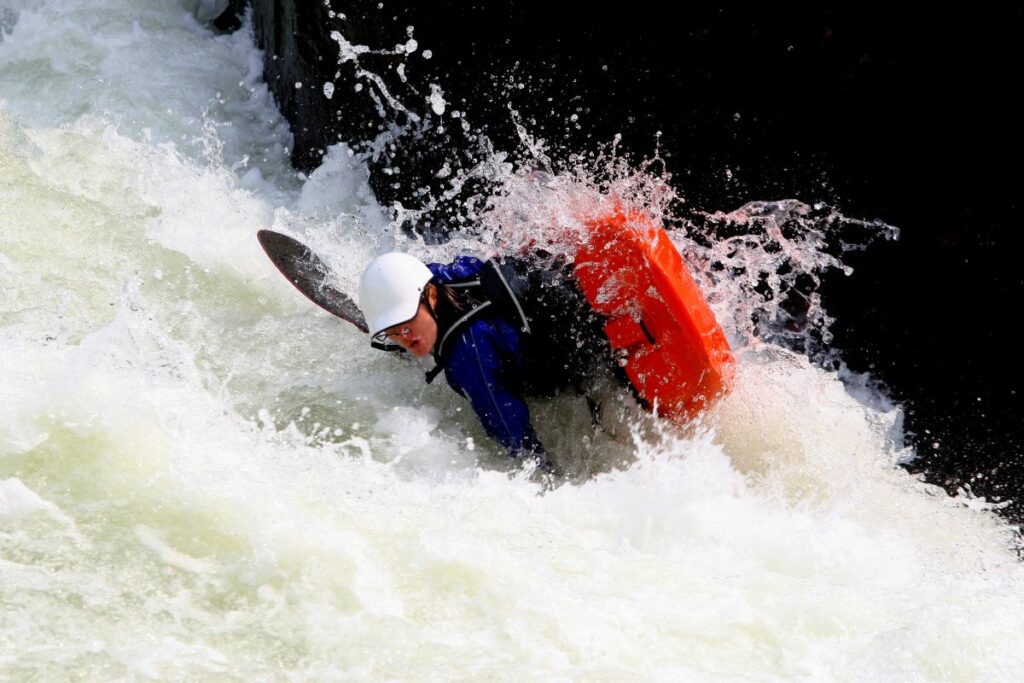
It’s unlikely to get stuck in a kayak if it flips over, especially if the paddler is wearing a properly fitted lifejacket and the kayak is designed with safety features.
In sit-on-top kayaks, the open cockpit design allows for easy entry and exit, which reduces the risk of getting stuck. If the kayak flips over, the paddler can easily swim out of the kayak and climb back on top.
The self-bailing design of sit-on-top kayaks allows any water that enters the kayak to drain out through small holes in the bottom, preventing it from filling up and becoming heavy.
In sit-inside kayaks, the closed cockpit design can make it more difficult to exit the kayak if it flips over. However, sit-inside kayaks are designed with safety features that make it easier to exit the kayak in the event of a capsize.
For example, a release cord or manually removable skirt covers the cockpit, which can be pulled to release the paddler and allow them to swim out of the kayak.
Overall, it’s important to practice self-rescue techniques and wear a properly fitted lifejacket when kayaking, regardless of the type of kayak being used. With the right precautions, the risk of getting stuck in a kayak after a capsize can be minimized.
What to Do If Your Kayak Flips Over?
If your kayak flips over, the most important thing to do is to remain calm and follow these steps:
- Stay with your kayak: Try to keep hold of your kayak and stay near it. This will make it easier to re-enter the kayak and retrieve any gear that may have fallen out.
- Remove your spray skirt (if applicable): If you are in a sit-inside kayak and have a spray skirt covering the cockpit, remove it as soon as possible to allow yourself to escape from the kayak.
- Position yourself and your kayak: Position the kayak so that it is right side up and the bow is pointing into the wind or current. You should position yourself so that you are facing the kayak with one hand on the kayak and the other hand on your paddle.
- Re-enter the kayak: Depending on your skill level and the type of kayak, there are several ways to re-enter a flipped kayak, such as a wet exit followed by a re-entry, a paddle float re-entry, or a T-rescue. It’s important to practice these techniques in a safe and controlled environment before attempting them in an emergency situation.
- Bail out water: Once you are back in your kayak, use a bilge pump or sponge to remove any water that may have entered the kayak.
- Retrieve lost gear: If any gear has fallen out of the kayak, retrieve it and secure it back in the kayak.
- Resume paddling: Once you are back in your kayak and have removed any excess water, resume paddling and continue your trip.
By following these steps, you can safely recover from a flipped kayak and avoid getting stuck
Here is a video showing how to do a wet exit but at the 1:25 mark, he shows exactly what I’m explaining:
How to Free Yourself If You Get Stuck in the Kayak?
If you get stuck in a kayak, whether it’s due to a capsize or getting wedged in the kayak in some other way, it’s important to remain calm and try to free yourself using the following steps:
- Attempt to wiggle or twist your body: Try to move your body back and forth or side to side to loosen any tight spots.
- Push or pull on the kayak: Use your hands or feet to push or pull on the kayak to try to create more space.
- Use your paddle: If you have a paddle, use it to try to create more space by pushing against the kayak or using it as a lever to pry yourself free.
- Remove any gear or equipment that may be causing the obstruction: If you have any gear or equipment that is blocking your escape, try to remove it or move it out of the way.
- Call for help: If you are unable to free yourself, call for help. If you have a whistle or other signaling device, use it to attract attention.
How to Get Back Inside the Kayak?
Getting back inside a kayak after capsizing, also known as a kayak re-entry, differs between sit-on-top kayaks and sit-inside kayaks.
Sit-On-Top Kayak
The easiest and most common reentry method is the “swim-on” method for Sit-On-Top kayaks. To perform the swim-on method, follow these steps:
- Swim to the stern of the kayak and grab the handles or the sides of the kayak.
- Kick your feet to propel your body forward while pulling yourself up onto the kayak.
- Once you are lying on the kayak, use your hands to crawl forward to your seat.
- Sit up and adjust your balance, and then start paddling again.
Sit-Inside Kayak
For Sit-Inside kayaks, there are different reentry methods, depending on the skill level of the kayaker and the type of kayak:
- Wet Exit and Reentry: This is the most basic reentry method for a Sit-Inside kayak. It involves pulling the spray skirt off the kayak and then getting out of the kayak in the water.
- To reenter the kayak, flip it over and hold onto the cockpit rim while kicking your legs to propel yourself onto the kayak.
- Once you are in a stable position on top of the kayak, you can slide back into the cockpit and use your paddle to stabilize yourself.
- Paddle Float Reentry: This method requires the use of a paddle float, which is an inflatable device that attaches to the end of your paddle to increase buoyancy.
- To perform a paddle float reentry, first, flip the kayak over and inflate the paddle float. Then, hold the paddle float in one hand and the paddle in the other hand, and position the paddle float behind the cockpit of the kayak.
- With the paddle float stabilized, climb onto the kayak and position yourself on the back deck, facing the bow. Slide yourself into the cockpit and use the paddle to stabilize the kayak as you sit up.
- T-Rescue: The T-rescue is a reentry method that involves the assistance of another kayaker.
- To perform a T-rescue, the assisting kayaker paddles their kayak perpendicular to the capsized kayak and then braces their paddle against the capsized kayak.
- The capsized kayaker then grabs the assisting kayaker’s cockpit rim and pulls themselves up onto the assisting kayaker’s kayak, and once they are in a stable position, they can slide back into their own kayak.
Remember, it’s important to practice different kayak reentry methods in a safe and controlled environment to build confidence and ensure your safety in case of an emergency.
Kayak your way to Freedom
- On a budget? Check out the best fishing kayaks under $500 here and the best Fishing Kayaks under $1,000 here. Or Check the best Cheap Kayaks here.
- Going fishing? Here are the best Ocean fishing kayaks, and here are the best River Fishing Kayaks.
- You can also find the best Fly Fishing Kayaks here and the best Bass Fishing Boats here.
- A bit experienced? Check out the best modular kayaks here and the best tandem fishing kayaks here.
- Looking for something special? Check out my favorite Ducky kayaks here.
- Navigate your way with these awesome and beginner-friendly Kayak compasses.
- Going Hunting? These Duck hunting kayaks will give you an unfair advantage!
- Have a need for speed? These motorized kayaks will get you moving.
- Protect yourself from the sun with these Kayak shades, and make your kayak more comfortable with these Kayak seats.
- Keep your feet dry and warm with these superb Kayaking shoes.
- Going Kayaking in cold water? Stay warm with these Kayaking gloves.
- Paddle Less, Fish More with the Best Kayak Motors
- Looking to get a trolling motor on your kayak? Check out the best kayak trolling motor mounts here.
If you like this article, please share it or pin it, you can find the share buttons below. We will really appreciate it ❤️

